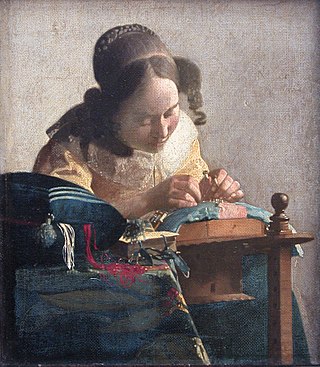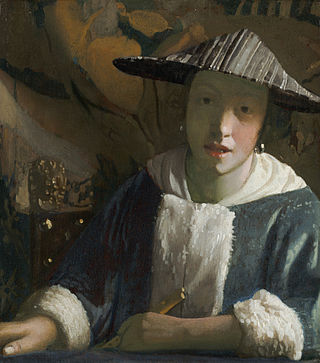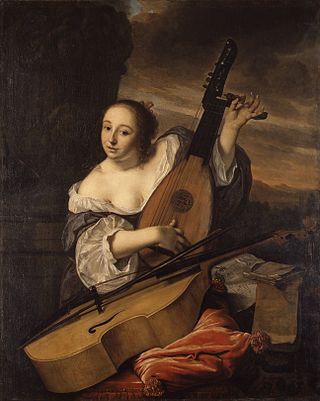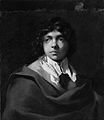
Johannes Vermeer was a Dutch Baroque Period painter who specialized in domestic interior scenes of middle-class life. He is considered one of the greatest painters of the Dutch Golden Age. During his lifetime, he was a moderately successful provincial genre painter, recognized in Delft and The Hague. He produced relatively few paintings, primarily earning his living as an art dealer. He was not wealthy; at his death, his wife was left in debt.

Gerard ter Borch, also known as Gerard Terburg, was a Dutch genre painter who lived in the Dutch Golden Age. He influenced fellow Dutch painters Gabriel Metsu, Gerrit Dou, Eglon van der Neer and Johannes Vermeer. According to Arthur K. Wheelock Jr., Ter Borch "established a new framework for subject matter, taking people into the sanctum of the home", showing the figures' uncertainties and expertly hinting at their inner lives. His influence as a painter, however, was later surpassed by Vermeer.

The Art of Painting, also known as The Allegory of Painting, or Painter in his Studio, is a 17th-century oil on canvas painting by Dutch painter Johannes Vermeer. It is owned by the Austrian Republic and is on display in the Kunsthistorisches Museum in Vienna.

The Milkmaid, sometimes called The Kitchen Maid, is an oil-on-canvas painting of a "milkmaid", in fact, a domestic kitchen maid, by the Dutch artist Johannes Vermeer. It is in the Rijksmuseum in Amsterdam, the Netherlands, which regards it as "unquestionably one of the museum's finest attractions".

Woman with a Water Jug, also known as Young Woman with a Water Pitcher, is a painting finished between 1660–1662 by the Dutch painter Johannes Vermeer in the Baroque style. It is oil on canvas, 45.7cm × 40.6 cm, and is on display at the Metropolitan Museum of Art, New York.

Saint Praxedis is an oil painting by Johannes Vermeer. This attribution has often been questioned. The painting is believed to be a copy of a work by Felice Ficherelli that depicts the early Roman martyr, Saint Praxedis or Praxedes.

Fourteen Rembrandt paintings are held in collections in Southern California. This accumulation began with J. Paul Getty's purchase of the Portrait of Marten Looten in 1938, and is now the third-largest concentration of Rembrandt paintings in the United States. Portrait of Marten Looten is now housed at the Los Angeles County Museum of Art (LACMA).

The Lacemaker is a painting by the Dutch artist Johannes Vermeer (1632–1675), completed around 1669–1670 and held in the Louvre, Paris. The work shows a young woman wearing a yellow bodice, holding up a pair of bobbins in her left hand as she carefully places a pin in the pillow on which she is making her bobbin lace.

The Allegory of Faith, also known as Allegory of the Catholic Faith, is a Dutch Golden Age painting by Johannes Vermeer from about 1670–1672. It has been in the Metropolitan Museum of Art in New York since 1931.

Woman with a Lute, also known as Woman with a Lute Near a Window, is a painting created about 1662–1663 by Dutch painter Johannes Vermeer and now at the Metropolitan Museum of Art in New York.

Woman Reading a Letter is a painting by the Dutch Golden Age painter Johannes Vermeer, produced in around 1663. It has been part of the collection of the City of Amsterdam since the Van der Hoop bequest in 1854, and in the Rijksmuseum in Amsterdam since it opened in 1885, the first Vermeer it acquired.

Girl Reading a Letter at an Open Window, also known as Lady reading at an open window, is an oil painting by Dutch Golden Age painter Johannes Vermeer. Completed in approximately 1657–1659, the painting is on display at the Gemäldegalerie in Dresden, which has held it since 1742. For many years, the attribution of the painting—which features a young Dutch woman reading a letter before an open window—was lost, with first Rembrandt and then Pieter de Hooch being credited for the work before it was properly identified in 1880. After World War II, the painting was briefly in possession of the Soviet Union. In 2017, tests revealed that the painting had been altered after the painter's death.

Woman with a Pearl Necklace by Johannes Vermeer is a Dutch Golden Age painting of about 1664. Painted in oils on canvas, Johannes Vermeer portrayed a young Dutch woman, most likely of upper-class descent, dressing herself with two yellow ribbons, pearl earrings, and a pearl necklace. As a very popular artist of the 17th century, the Dutch Golden Age, Vermeer depicted many women in similar circumstances within interior, domestic scenes. The same woman also appears in The Love Letter and A Lady Writing a Letter.

Mistress and Maid is an oil-on-canvas painting produced by Johannes Vermeer c. 1667. It portrays two women, a mistress and her maid, as they look over the mistress' letter. The painting displays Vermeer's preference for yellow and blue, female models, and domestic scenes. It is now in the Frick Collection in New York City.

Girl with a Flute is a small painting attributed to either Johannes Vermeer or one of his associates. It is currently believed to have probably been painted between 1669–1675. It is owned by the National Gallery of Art in Washington, D.C. along with three paintings attributed to Vermeer: Woman Holding a Balance, A Lady Writing a Letter, and Girl with a Red Hat.

Man Writing a Letter is an oil painting on a wood panel by Gabriël Metsu made at the height of his career. It is assumed to be a pair with Woman Reading a Letter. The two genre paintings are regarded as Metsu's artistic climax. Since 1987 they can be seen in the collection of the National Gallery of Ireland in Dublin.

Woman Reading a Letter is an oil painting by Dutch artist Gabriël Metsu, created c. 1665–1667, shortly before his death. During his lifetime, under the Golden Age of Dutch painting Metsu was a renowned painter, much better known than Vermeer. It is assumed to be a pair with Man Writing a Letter.

Young Woman in a Pearl Necklace is an oil on canvas painting by an unknown painter, after a painting by the Dutch painter Willem Drost. It is an example of Dutch Golden Age painting and is part of the collection of the Metropolitan Museum of Art.

The Musician (1662) is an oil on canvas painting by the Dutch painter Bartholomeus van der Helst. It is an example of Dutch Golden Age painting and is part of the collection of the Metropolitan Museum of Art.

Johannes Vermeer was a Dutch Baroque Period painter who specialized in domestic interior scenes of middle class life. His works have been a common theme in literature and films in popular culture since the rediscovery of his works by 20th century art scholars.





















